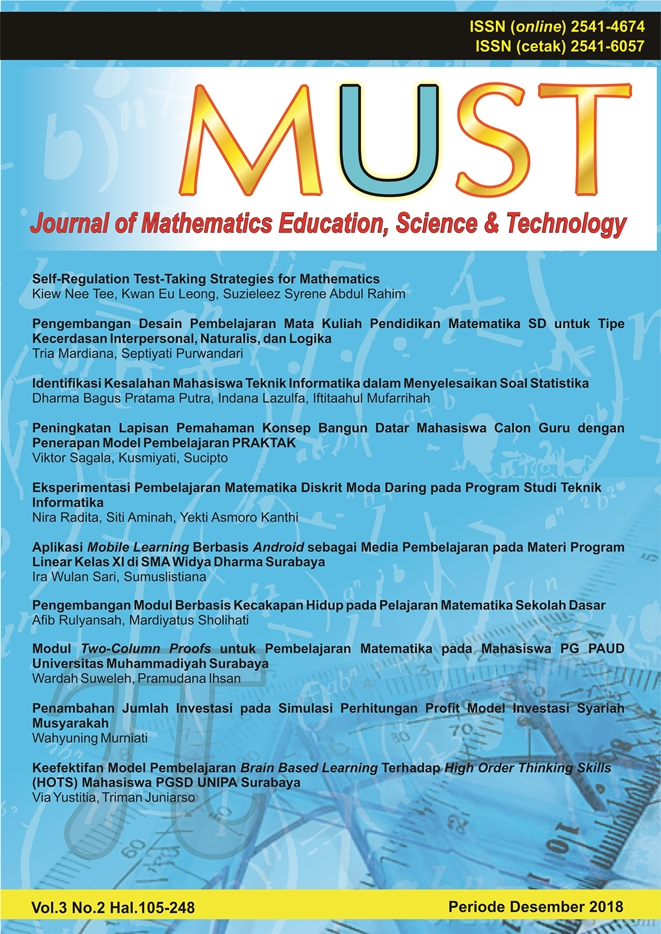Eksperimentasi Pembelajaran Matematika Diskrit Moda Daring pada Program Studi Teknik Informatika
Abstrak
Artikel teks lengkap
Referensi
Alghazo, A. 2005. Comparing Effectiveness of Online and Traditional Teaching UsingStudents’ Final Grades. Online Journal for Workforce Education and Development OJWED 1(3): 1-11. Dapat dilihat di: http://opensiuc.lib.siu.edu/cgi/viewcontent diakses pada tanggal 3 Oktober 2018.
Al-Qahtani, A. A. Y., Higgins, S.E. 2013. Effect of Traditional, Blended and E-Learning on Students Achievement in Higher Education. Journal of Computer Assisted Learning. Vol. 29, No. 3. Hal: 220-234.
Creswell, J. W. 2009. Research Design: Qualitative, Quantitative, and Mixed Methods Approaches. California: Sage Publication, Inc.
Dimitrios, Belias., Labros, Sdrolias., Nikolaos, Kakkos., Maria, Koutiva., Athanasios, Koustelios. 2013. Traditional Teaching Methods Vs. Teaching Through the Application of Information and Communication Technologies in the Accounting Field: Quo vadis? European Scientific Journal, Vol. 9, No. 28.
Hassenburg, A. 2009. Distance Education Versus the Traditional Classroom: Comparing the Traditional Classroom to the Virtual One, Does Being Phisically Present in School Make a Difference? Berkeley Scientific Journal Technology and Human Interaction. Vol. 13 Issue 1. Hal: 7-10.
Means, B., Toyama, Y., Murphy, R., & Baki, M. 2013. The Effectiveness of Online and Blended Learning: A Meta-Analysis of the Empirical Literature. Teachers College Record.
Ni, A. Y. 2013. Comparing the Effectiveness of Classroom and Online Learning: Teaching Research Methods. Journal of Public Affairs Education, 199.
Stack, S. 2015. Learning Outcomes in an online vs traditional course. International Journal for the Scholarship of Teaching and Learning. Vol. 9, No. 1. (online). https://doi.org/10.20429/ijsotl.2015.090105.
Penulis
Penulis yang menerbitkan artikel di Jurnal MUST menyetujui persyaratan berikut:
Penulis memiliki hak cipta dan memberikan hak publikasi pertama kepada Jurnal MUST dengan karya yang secara simultan dilisensikan di bawah Creative Commons Attribution-NonCommercial 4.0 International License yang memungkinkan orang lain untuk berbagi karya dengan pengakuan kepengarangan karya dan publikasi awal dalam Jurnal MUST.
Penulis dapat mengadakan perjanjian kontrak tambahan yang terpisah untuk distribusi non-eksklusif versi jurnal yang diterbitkan dari karya tersebut (misalnya, mempostingnya ke repositori institusional atau menerbitkannya dalam sebuah buku), dengan pengakuan atas publikasi awalnya di Jurnal MUST.
Penulis diizinkan dan didorong untuk memposting pekerjaan mereka secara online (misal dalam repositori institusional atau di situs web mereka) sebelum dan selama proses pengiriman, karena dapat menyebabkan pertukaran yang produktif, serta kutipan yang lebih awal dan lebih besar dari karya yang diterbitkan.

